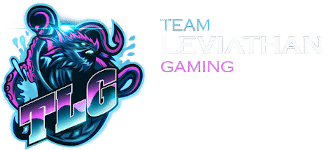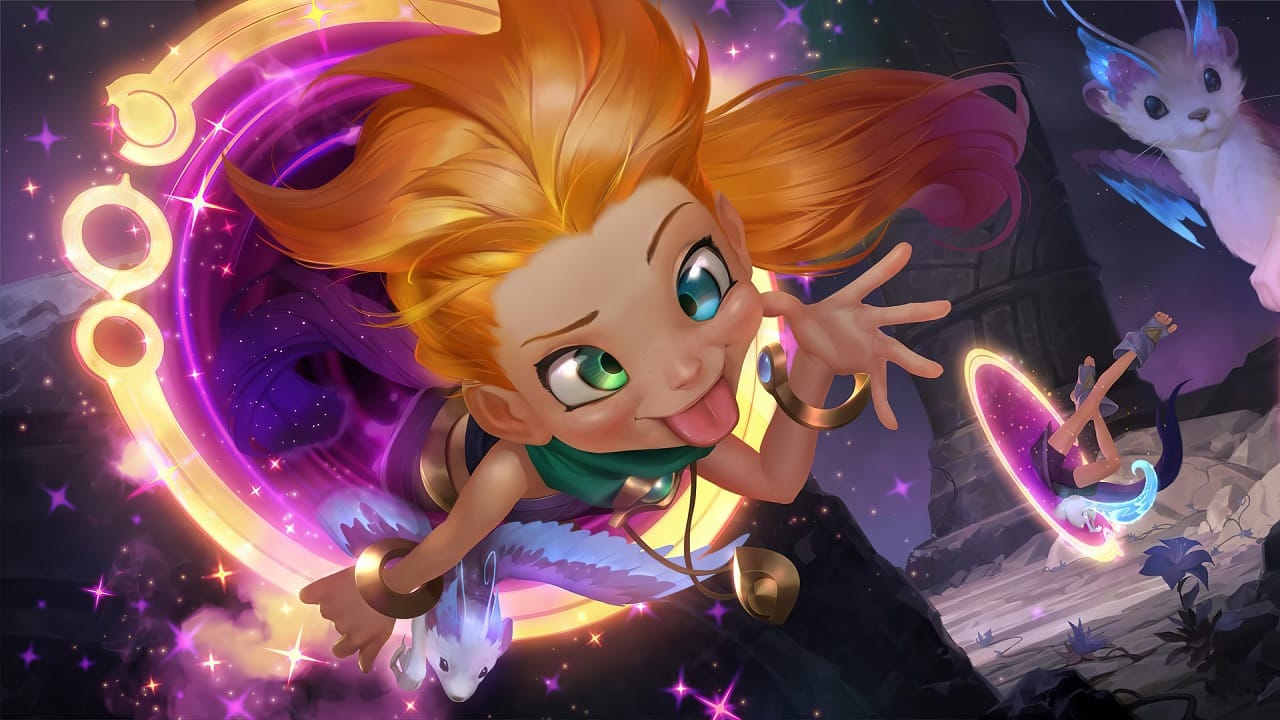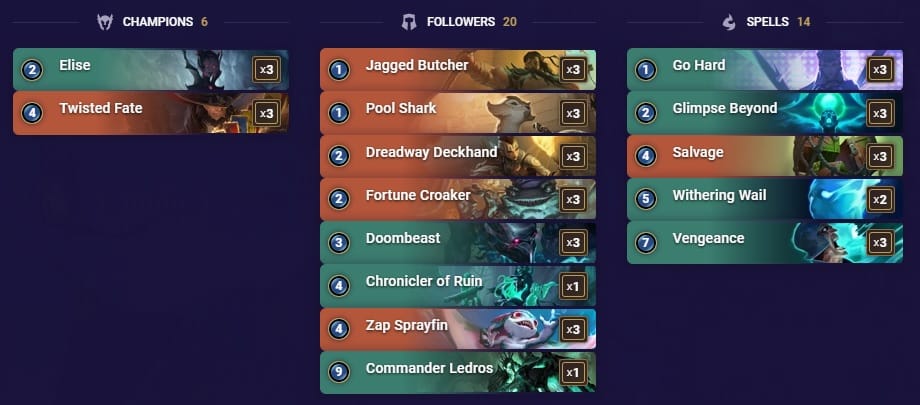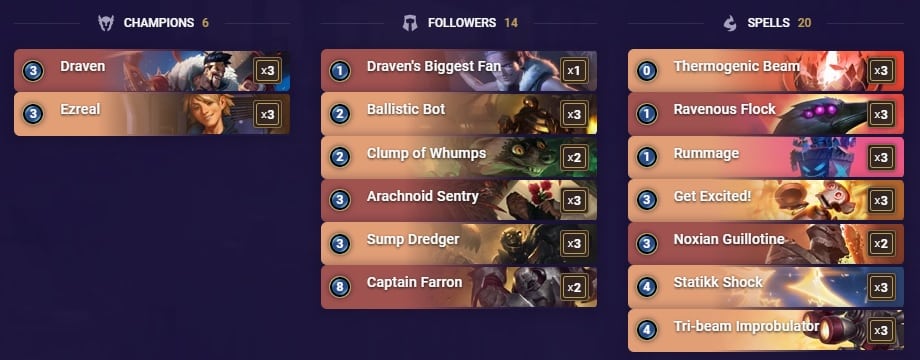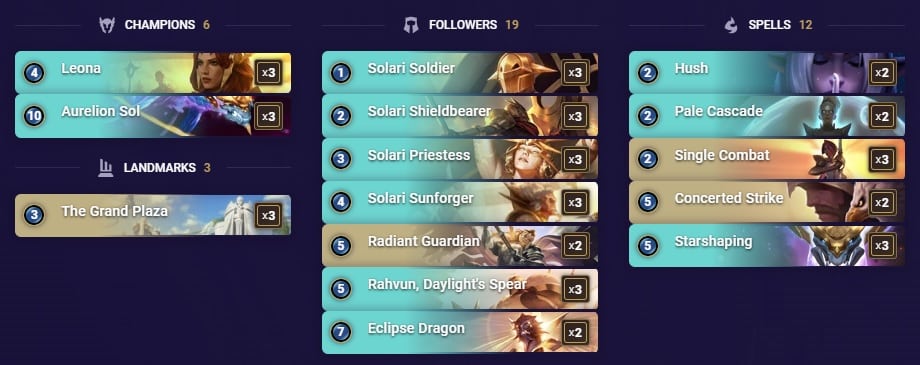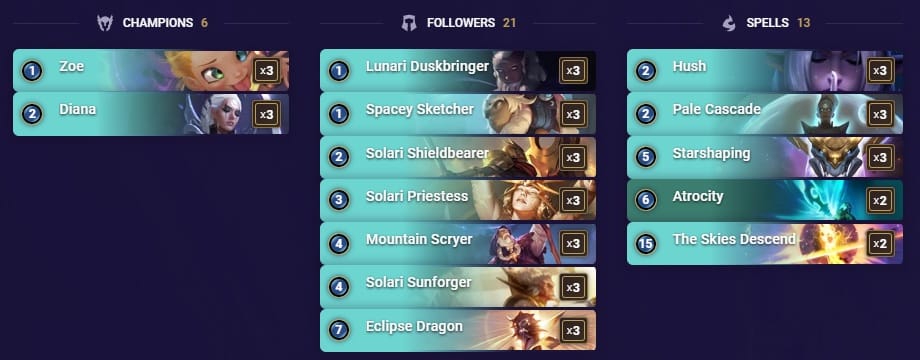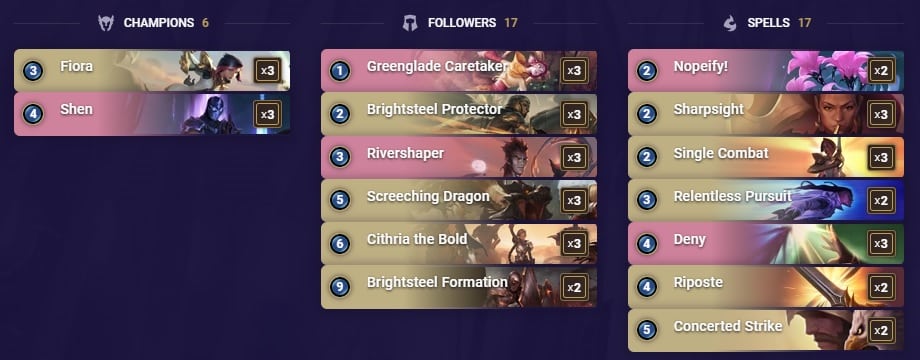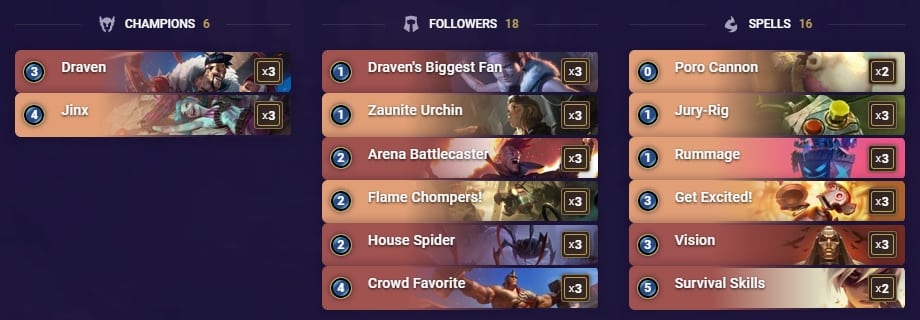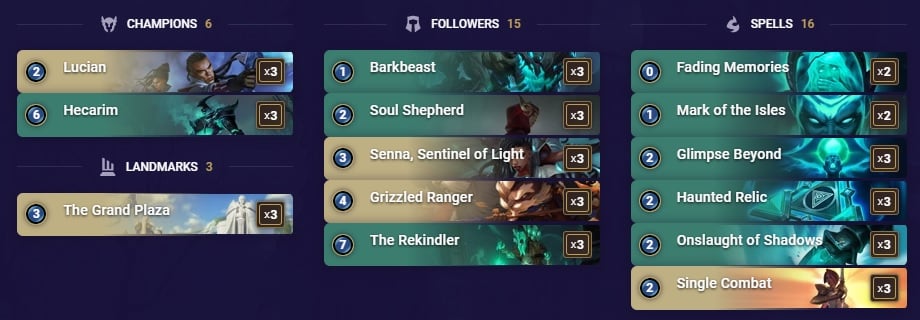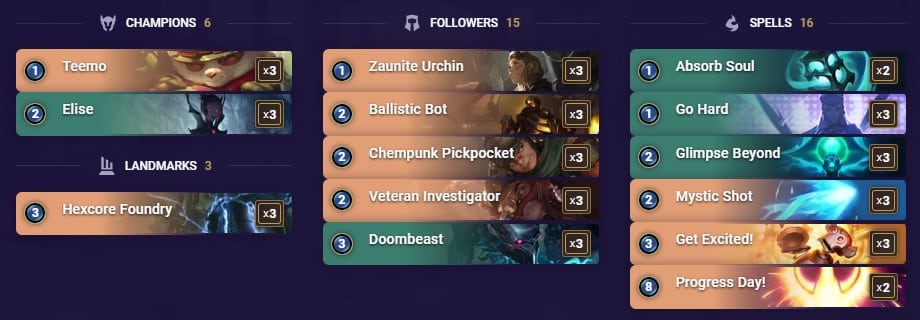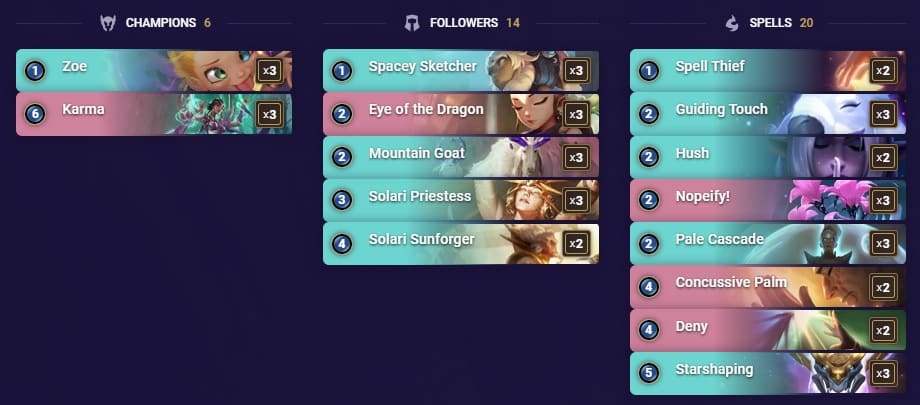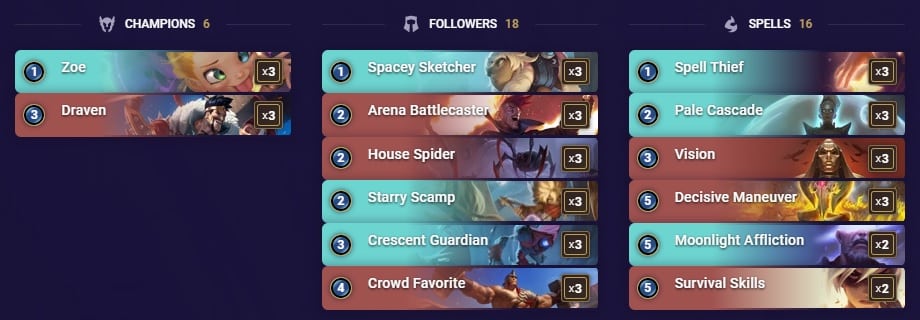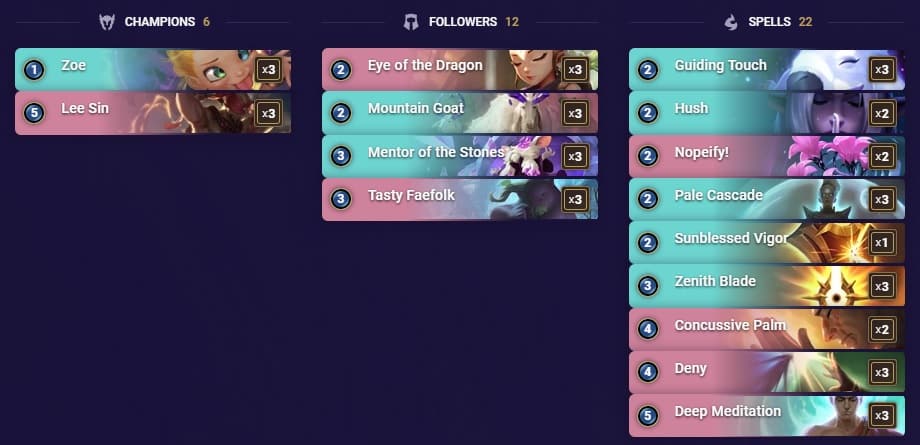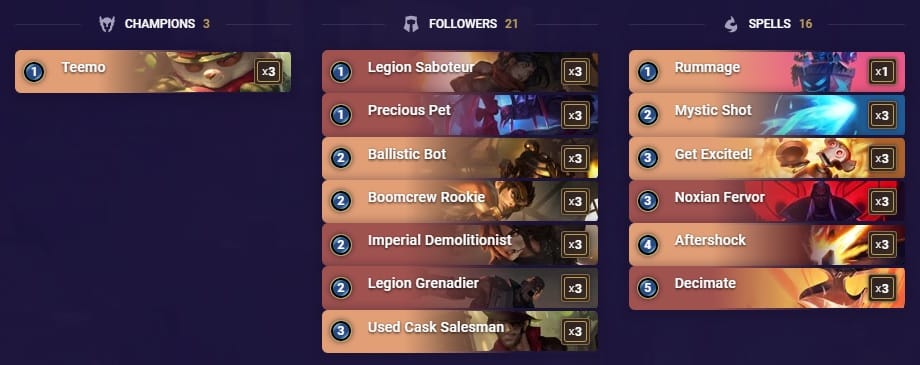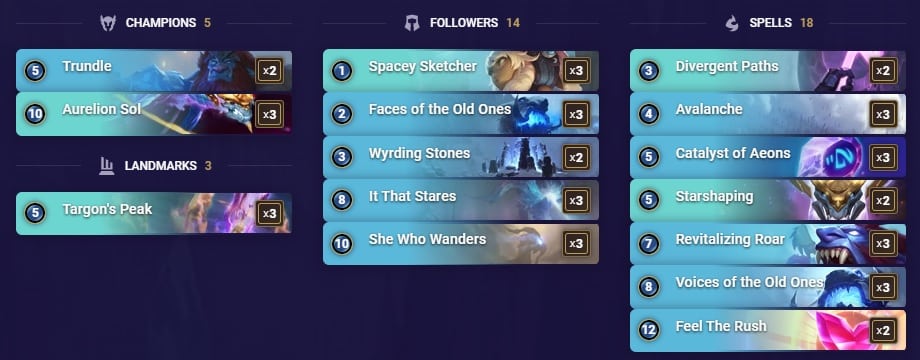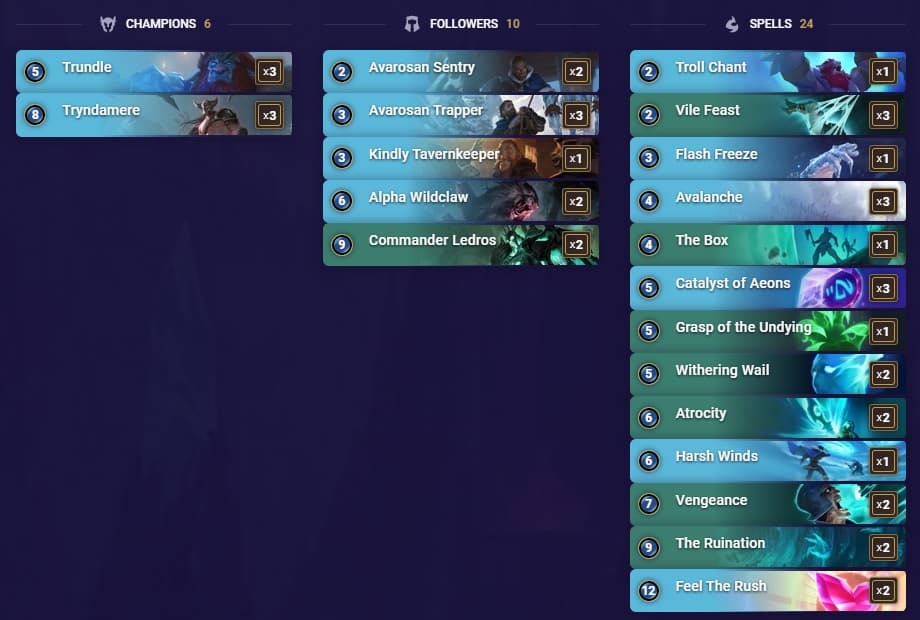Welcome to TLG’s latest meta snapshot for Legends of Runeterra, a series in which we give you our insight on the finest decks in the higher ranks of the ladder.
Every Monday, we discuss the decks that are part of the week’s meta and rate them on a scale of 1 to 5 stars. We also look at the evolution of said decks’ ratings across weeks and draw conclusions regarding the current state of the game, all of this so you can delve into your own ranked journey with a head start.
This week, the meta has stabilized and we can give you some more concrete ratings to the decks. The top 3 decks include Go Hard, Ezreal-Draven and Leona-ASol with The Grand Plaza. There are 3 new decks which all involve Zoe in combination with different champions, namely Karma, Draven and Lee Sin.
Burn isn’t in a good spot at the moment, as healing is much cheaper than burning. The meta is also very resource-centric, with multiple decks being able to draw, create or cycle more and more threats. As a result, your games should feel a little longer than usual.
If you have any questions, feel free to drop by our Discord. Best of luck on your climb!
Graphics: WellMax81
Editing: Crixuz, Den, Wusubi, Sebodunum, Ultraman
EU Consultants: CastMin, Kuvira, Pespscola, Zezetel
NA Consultants: NicMakesPlays, RattlingBones

CICACAYGBABAGBIGCABQCBIBGE2QMAQGAQERUHJGHIAQCAIFDUAQEAIFEAQQ
The best deck in the previous meta still stands at the forefront, perhaps even more so than before. Although Lee Sin has proved to be a fair counter to the deck, Zoe looks to be one of the most played champions at the moment, offering flexibility to a lot of lists thanks to her card generating ability. This new addition to the game makes Go Hard even better, as Zoe is of course a prime target for Go Hard. Alongside this, Go Hard has kept good matchups with most of the other popular decks.
Other than this change to the environment, the list itself hasn’t changed at all and its powerlevel still looks to be off the charts. It holds Aggro decks to respectable grounds while simply the anticipation of Pack Your Bags sets up awkward situations and forces suboptimal plays from your opponent in their attempt to work around it. In a meta where tempo is the most important factor, Go Hard looks to be one of the best cards out there and the deck surrounding it maximizes its power.
Once the deck is able to seize tempo and get its synergy going, there isn’t much that most other decks can do to stop it, as it applies immense pressure to both the board and its opponent’s health. While greedy decks like Feel the Rush or Targon’s Peak can beat it consistently, the meta isn’t centered around those decks and Go Hard appears to be a lock as the best deck for the weeks to come. (Write-up by Den)
CICACAQDBEBACAYUFYBAGBAFCEDACBABDMPSIJRHAIAQCBBVAIAQGFRTAEAQCAZD
After a quick digression with Riven, Ezreal & Draven were reunited to terrorize the ladder. With the Ballistic Bot as the only new addition to the deck, this archetype continues to contend for the top spots in our meta snapshot. The addition of Ballistic Bot should not be glossed over here, as it serves as a card generator that can be used to activate all of the decks’ synergies. He also has a very special relationship with Draven, as he gets +1 attack when an axe gets used, even if he isn’t the target for it.
Ezreal-Draven is probably the best board control deck as well as being a tempo machine in the mid game. Moreover, the deck has the option to incorporate one of the high profile tech cards for this meta in Scorched Earth. This card not only has perfect synergy with Tri-beam Improbulator and Statikk Shock, but also has the ability to destroy The Grand Plaza.
Scorched Earth can replace Noxian Guillotine, so the deck can more readily answer Scouts, Lucian-Hecarim and Leona-ASol. The Grand Plaza is central to all of the aforementioned decks, so denying their opportunity to gain favourable trades will be a gigantic boon to your chances of winning with this deck.
Although 35/40 cards are the exact same as in the previous dominant lists, Ezreal-Draven is now more solidly anchored as the second best deck currently, only feeling weak against Go Hard so far. (Write-up by Den)
CIBQCAIADIAQGAAKBABQSGQ4GY4VIV2YMABQCAIAB4AQEAABAMBQSI2VMQAA
The party is well and truly on at the Plaza this month. This particular version takes a different approach by using the landmark as a defensive tool. While most decks use it mainly for trades, this one relies on the extra healing provided by Solari Sunforger in order to survive the early game. The great curve leads to some comeback potential, especially with Plaza in play. Single Combat and Sunforger have the capacity to heal up to 12 HP on an offensive Turn 4, for example.
They say the best defense is a good offense, and it has never been more true. If you somehow still end up behind, you’ll have to rely on Radiant Guardian and Concerted Strike to regain the board and reduce the opponent’s damage output.
Early Solari followers will help you avoid falling behind too much in the games where you don’t find Plaza or Sunforger, while Starshaping can be used to avoid certain death. It must be said that due to the vast loss in tempo that Starshaping represents, you don’t want to use it until you have taken the board back, so keep it as a way to survive, but don’t rely on the healing until you’re strong enough to absorb your opponent’s next move.
Finally, while Leona and the tempo of your value trades could lead to a win in the end, you’ll still be relying on ASol to close out most control games, as your damage potential remains low and you’re exposing yourself to hard removals and AoEs (cards like Pack Your Bags or The Ruination). Drop the enormous dragon and watch them tremble in fear of your own scary removals and created Celestial Elusives! (Write-up by Ultraman)

CEAQYAYJBEOCGOBZJFGFIVKWMBSAEAIBAUMQCAYJAIAA
Targon Allegiance has been an archetype since the release of Call of the Mountain. It has seen a lot of variants, but the one with the most recent success was Leona-Diana with an Atrocity splash. This deck is very similar to Leona-Diana, the major difference being Zoe replacing Leona. Why has that happened? Well, Leona became an easy cut because of Solari Sunforger.
Why is Zoe good? Zoe is a value engine that forces answers which, in most cases, trade down in mana. One Nexus Strike from Zoe is already very valuable, because your deck synergizes with your cards in such forms as the discount from Mountain Scryer, the discount on The Skies Descend and Zoe’s creation of Behold the Infinite (in her levelled form) to gain access to expensive Invoke spells and thereby make the apex Invoke units stronger when they’re summoned.
To give a short overview of the key cards: Mountain Scryer is the best value engine in the deck, The Skies Descend can give you the edge vs Midrange and Atrocity provides a bit more reach. (Write-up by Pespscola)
CIBQEAYAAYHAIAIABENC2MYEAEBBGIBLGEBQCAQAAEAQGAQUAMAQAFJFGQAA
Fiora-Shen is a Midrange deck with multiple win conditions, namely through board pressure or trading four times with Fiora. Most of the game plan is trying to be the one in the driver’s seat; from there, you can decide on which specific win condition you’re aiming at. If you lose control of the game, you lose the opportunity to do this.
In order to gain this momentum, the deck is stacked with combat tricks (e.g. Sharpsight, Riposte) and ways to force combats (Single Combat, Concerted Strike) that protect your board and interact with the opponent’s even outside of the combat phase. Drawing is of course very important, and Rivershaper is the star of the show in that regard. Combined with Barriers and all the support cards in your deck, you can abuse it and cycle your deck pretty efficiently.
Relentless Pursuit is the new addition to the list, a strong card usually seen in MF Scouts. Here, it allows the player to pressure their opponent by trading with barriers and then attacking again, or to take the value trade from your Challengers when the opponent thinks it’s safe to develop their board.
Overall, this is a “do it all” archetype, which can go in different directions and allows the player to focus on various game plans. It’s important to note that the list has a tendency to lose to itself when it’s unable to get on board in the early game, as having the tempo advantage is still a key component to the deck’s success. (Write-up by Den)
CIBAMAIDA4ERIIZHG4DACBABBQOCOKBNAIAQGAYPAEBQIEQA
Discard Aggro is a swarm deck that wants to play a lot of units in order to slam a huge Crowd Favorite. A big aspect of playing this is knowing when and how to discard cards. Especially when you’re in a pinch, Draven’s Spinning Axes are a reliable way to be able to Discard something for free. To be a good Discard Aggro player, it’s important to focus on your win condition rather than focusing on cards that don’t advance your game plan. A good example would be discarding Jinx with Spinning Axes so that you can play Vision for free.
Jinx isn’t going to be relevant in every game, especially if you can kill the opponent with your swarm board in 2 turns, so this is something to take into consideration. Too often I see people not closing games because they want to play Jinx when really Jinx is pulling you into a different (and worse) game plan.
A new addition to the archetype is Survival Skills. When played, your allies cannot drop below 1 HP. More importantly for this list’s purposes, though, is that when it’s discarded, your strongest unit cannot drop below 1 HP this round. (Write-up by Crixuz)
CICQCAQABEAQEBIGAEBQACQDAEABMGRGAYAQKBYKCQLSUMIBAIAQKFRPAA
The Ephemeral keyword didn’t really have a home for a while. Although the whole mechanic has fairly efficient support cards (Fading Memories & Soul Shepherd) and also has several champions benefiting from it (Lucian, Kalista, Hecarim), it has never really clicked. Now, though, it looks like the time has come for the undead to be back as a dominant archetype thanks to the new landmark: The Grand Plaza.
The problem with Ephemeral followers has always been their volatility, the keyword not allowing the player to establish a board presence from one turn to another and therefore falling behind in the mid game. Now that The Grand Plaza landmark allows the followers to get the Challenger tag, the Ephemeral tag isn’t so much of a problem and the deck can control the board until its Ephemeral synergy builds up and takes over the game.
With the looks of an aggressive deck trying to go all-in, the deck actually builds toward a huge Hecarim when the early game pressure doesn’t work; its strongest turns in this case are usually in the 5-8 range. If the opponent cannot keep up, then Lucian has all the support he needs to evolve (Senna, Single Combat), which allows you to attack multiple times. (Write-up by Den)
CICQCAQEBIBACBJRGUBAGBAFCQBAGBIGCACQCBAIE4VS2NACAEAQIMIBAECS2AA
Go Hard relies on drawing, and what’s a better way to draw than Hexcore Foundry? Sure, it also draws cards for your opponent, but most decks will eventually run out of mana to play every single one of these cards drawn thanks to Veteran Investigator and the landmark itself. With the low average card cost in this list, you should be able to cycle your Go Hards into a Pack Your Bags relatively easily, all the while applying more and more pressure on your opponent.
Teemo is the only part of the Mushroom package to feature here. Although Puffcaps can burn down your opponent’s Nexus, the amount of mana invested in them is rarely worthwhile. Moreover, focusing heavily on stuffing your opponent’s deck with Puffcaps made the deck even more reliant on finding Hexcore Foundry.
This version of the list prioritizes damage (especially Burn) and healing, helping you survive long enough for the Foundry to get you to Pack Your Bags. Mystic Shot, Doombeast and Get Excited! will turn the opponent's Nexus to dust. (Write-up by Ultraman)
CICACAICFEAQEAQDAEBQEFAHAMEQSIZTKRLFYYADAEAQEMIBAIBAKAYDBEVDSVIA
The myriad methods of healing in this list pair nicely with your overall game plan: stalling. You want to stall and stall until either your opponent wears themselves out, or your Creates start generating threats to their Nexus. With a decent ability to prevent trades and sufficient early game pressure to survive aggression, you still have to rely on your early minions to suppress part of the opponent’s board pressure. If you lived through that, the great healing ability coupled with big minions from Starshaping will save you most of the time.
Karma is included because in her levelled form, she has always been a big threat in the late game. Here, though, she gives you the ability to get 10 healing for 5 mana (not counting the double Create), which can give you a lifeline in very desperate games. Nopeify! is a must in this Go Hard meta and Zoe helps you retain the card advantage while defending yourself. So, despite the lack of card draw in this deck, the frequent Creation of new cards will make up for it. (Write-up by Ultraman)
CIBAMAIDA4EQ2FBHG4DAGCIJEMVE6VSZAIAQGCINAEBQGDYA
Very similarly to Discard Aggro, this deck has a big high-roll potential in its swarm-oriented opening hand. An attack from Zoe can lead to big boards, from which Crowd Favorite and Vision will take advantage. Decisive Maneuver will help your Overwhelm units hit through blockers, while Moonlight Affliction will simply stop them from blocking altogether. Unless your opponent has Fast speed answers, they will be done for. If you don’t get a perfect opening hand, try to put in some chip damage and find a way to steal the game!
Thankfully, this deck is pretty good at exactly that: stealing the game. With multiple ways of getting your damage through and various attack boosts in the form of Vision, Decisive Maneuver, Pale Cascade or Draven’s Spinning Axes, you have the ability to pounce on any of your opponent’s miscalculations. Prepare for some intense comebacks, even when you least expect it.
You’re also able to punish greedier decks, especially when they don’t attempt to halt your early game pressure, just by playing House Spider and Arena Battlecaster. However, beware of trading without much thought, as many of your cards rely on you having a relatively full board to be efficient and threaten your opponent. (Write-up by Ultraman)
CICACAICGEAQGAQJAMBAEAYGBEDAGCIJDMRSSM24AMAQEAQFAEBQEFABAMEVKAIBAMEWE
Zoe-Lee is the new take on the Lee Targon deck. Zoe is here for board presence. This might sound counterintuitive, but she does generate cheap units or stuns every time she strikes the enemy Nexus. This gives you a better matchup into decks like Plaza or Demacia in general. The rest of the deck is like older versions of Lee Sin.
Some notable cards are Pale Cascade, Guiding Touch and Deep Meditation for cycle, Zenith Blade to give Lee Overwhelm or to give extra health to Zoe or Tasty Faefolk. A copy of Sunblessed Vigor fulfils a similar effect to Zenith Blade, Mentor of the Stones and Mountain Goat are used for Gem generation and Concussive Palm for more board presence.
Deny and Nopeify! can interact with the opponent’s spells and finally Eye of the Dragon and Tasty Faefolk will offer you even more board presence and sustain. A consideration is changing the latter for Sparklefly. (Write-up by Pespscola)

CICAEAQDAMCAEAYEAUFQIAIDAIHSKKAFAECAQEJHGQ3AAAIBAECAC
If you type “damage” in the LoR deck-building client and put all the cards together, you’ll get PnZ Burn. This is a linear Aggro deck which is perfect for people who want rapid games. You want to start dealing damage from Turn 1, which means that your mulligans should reflect that by keeping or looking for Teemo, Legion Saboteur, Precious Pet etc. You should also follow up on that damage by having a Turn 2 and a Turn 3 play. Cards like Draven and Boomcrew Rookie mean that you’re guaranteed to connect damage to the Nexus.
By Turn 4, if you’re doing well, the opponent’s Nexus should be at 10-13 health. For the next 2-4 damage, this is where cards like Imperial Demolitionist and Legion Grenadier come into play. You usually shouldn’t keep Imperial Demolitionist in your opening hand because it might lead to awkward plays (e.g. killing your own Precious Pet). During the combat phase, you don’t want to block with any of your units.
Firstly, any damage you receive from not blocking isn’t going to matter, as the game is going to be decided way in advance before your Nexus ever goes down to zero. Secondly, by not blocking, you ensure having a wider board than your opponent (due to the nature of your units being cheaper) and hence can penetrate your opponent’s wall of blockers.
To close the game, you simply use the remainder of your Burn spells. Sometimes you might be 1-2 damage away and are just waiting to topdeck a relevant spell. In cases like this, you might want to stall by blocking just enough to buy you some time.
For example, if an opponent attacks with his full board, you don’t want to be blocking with all your units because then you will lose the board you worked hard to develop. Instead, just block the biggest unit and reserve your other units for future blocks. The nature of this deck is that you shouldn’t have to drag the game very long to find that last piece of damage.
In the current meta, healing spells are cheaper than Burn damage. Think about it. Solari Sunforger and Single Combat cost just 7 mana for 14 points of healing. For a Burn deck to actually deal 14 damage, it would require far more resources. Moreover, the healing right now is consistent. Looking at Plaza decks, they have access to not only Solari Sunforger, but also Radiant Guardian and Starshaping. In other words, they’re always going to have healing. The only reason PnZ Burn saw play on ladder was due to players experimenting in the first week. Now that decks are optimized, PnZ Burn is falling out of favor. (Write-up by Crixuz)

CIBQGAIBBQKDIAYDBFAFMVYEAMAQGBAKCMBQCAIBEEBAGAIGCYBAGCIFKQAA
Targon’s Peak (ASol-Trundle) is an extremely greedy deck that wants to cheat out big, beefy units like ASol, Feel The Rush and She Who Wanders by Turn 5-6.
The deck has two main game plans: (1) Stabilize first, or (2) Targon’s Peak first.
(1) Against Aggro decks, playing Targon’s Peak on Turn 5 is usually a losing play due to the loss of tempo. To mitigate this, you have to ensure that your tempo is equal to your opponent’s before committing to Targon’s Peak. One way of doing this is by making plays in the early game that result in a tempo swing in your favor. For example, Turn 1 Spacey Sketcher often means that you’ll have two units versus your opponent having one unit.
By making plays like this to ensure that you have the tempo advantage prior to Turn 5, you can play Targon’s Peak without losing the board. A more moderate position would be to play Avalanche. While it does tap you out of mana and allows the opponent to develop, they usually don’t have the resources to play too many units. For this game plan, it’s usually good to mulligan away your ramping tools because they’re by definition “tempo-reducing” for the player.
(2) The second game plan can be applied when you don’t care about tempo in the early game. This applies to matchups that are slower such as control decks (e.g. FTR) or even some Plaza decks. The idea is that since no combination of cards in the first 3-4 turns can bring down your Nexus health significantly, you can just wait to play Targon’s Peak and outvalue your opponent. In this game plan, you want to ramp. You also want to mulligan for your landmark.
Is this deck good? Targon’s Peak is a card that has a bilateral effect. This means that it doesn’t only reduce a random card of yours to zero, it does the same for your opponent as well. A second problem is that its effect is random. This means that very unfavorable situations can arise, for example your opponent’s Ledros and Atrocity being reduced to zero, while you only have Spacey Sketcher and Wyrding Stones reduced. For this reason alone, this deck can never be truly competitive.
However, LoR is a skill-intensive game and there are ways to mitigate this. Spacey Sketcher has a dual function here; it not only nets you the tempo advantage in the early game, but it also acts as a hand correction tool. Clearly, it’s crucial to play your low cost cards out before you drop your landmark in order to maximize the chance of it hitting something good.
In conclusion, Targon’s Peak is a blast to play and everyone should try it at least once, but we wouldn’t necessarily advise using this deck to climb the ladder. (Write-up by Crixuz, deck by Swim)
CIBQCAIFFAAQGAIGAQAQCDAUE4YAGAIDAELAEAIBAMNAKAIFAEHRSHJBAMAQGAICAIAQKEZWAMAQCAJKGI
Feel The Rush is a Freljord/SI control ramp deck. Its main win condition is to play Feel The Rush on T7 with the help of ramping tools like Wyrding Stones and Catalyst of Aeons. With the exception of Ionia lists, which have access to Deny, many decks find it very difficult to answer FTR’s huge tempo swing. Thus, if FTR resolves, the game is usually over. Atrocity is another crucial card, as it can help you to end the game one turn after FTR is played.
One important skill when playing Feel The Rush is banking mana so that you can play it as early as possible, or to keep yourself open in order to have enough mana for board wipes. For example, it might not be a good idea to play anything on T1 and T2 so you can play an Avalanche with no downsides on T4. Of course, a lot of this is matchup-dependent, but (as usual) being able to plan ahead will be helpful to pilot this deck well.
If possible, try to level-up Trundle before you play FTR, so that you have two Overwhelm units with 10/10 statlines to attack with. Trundle with the Overwhelm keyword can often be the difference between losing and winning. Against Aggro, it might not be a good idea to focus on ramping. Instead, you want to mulligan in search of an Avalanche. (Write-up by Crixuz)
